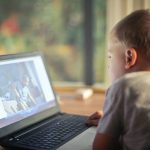Authored by Pattie Carroll
 Let’s face it, we are inundated with technology. We are raising children in a digital age and screens are part of our lives. Parents oftentimes wonder if their children are spending too much time in front of screens like phones, computers, laptops, televisions, etc.
Let’s face it, we are inundated with technology. We are raising children in a digital age and screens are part of our lives. Parents oftentimes wonder if their children are spending too much time in front of screens like phones, computers, laptops, televisions, etc.
First let’s take a look at how too much screen time affect children?
Toddlers learn best when they interact with other children and adults. Some screen time can be educational. But simple play is the most powerful learning experience for children. Too much screen time has negative impacts on children’s health and well-being. Time with screens means time away from other activities. For instance:
- More screen time leads to less interaction with family and friends which leads to fewer opportunities to develop problem solving and social skills
- More screen time leads to less activity which leads to more overweight children
- More screen time leads to less reading and talking which leads to slower language development
The problem is screens are fun and kids often want more. So, you might be asking, but how do I limit screen time?
To help keep limits:
1. Plan ahead what daily screen time looks like (three 20-minute shows? Friday movie night? A show while you cook dinner?). Then when your child asks for more, you can say, “How many shows do we watch?”
2. Set a timer to help your child know when screen time is up. Use this as a reminder to check in with your child and help them transition to the next activity.
3. Before starting screen use, tell your child what happens after screen time. “When this show is done, we’ll eat supper/go to daycare/have a dance party/go outside.” If this can be the same every day, the transitions are easier for kids.
4. Make technology work for you. Set passwords for devices. If you’re not using screens together, use “guided access” on Apple devices or “screen pinning” on Android devices to limit which apps and shows can be accessed. Set your child up for success by putting TVs on a timer that can be turned on and off with a remote or placing device remotes away from children’s reach.
 Turn away from your screen. Kids do what we do. Model limited screen use by putting away your phone during meals. Turn your phone off while you play with your child. Describe why you are picking up your device. Children learn from watching adults that screens are just one part of a balanced day.
Turn away from your screen. Kids do what we do. Model limited screen use by putting away your phone during meals. Turn your phone off while you play with your child. Describe why you are picking up your device. Children learn from watching adults that screens are just one part of a balanced day.
Practice screen-free activities. Keeping preschoolers entertained can be a difficult task due to their high energy levels. Build healthy habits by guiding preschoolers to screen-free activities they enjoy. By practicing independent, screen-free activities, kids are more likely to want to do these activities.
What I know is that screens are here, they are ubiquitous, and our children will have contact with screens. So here are some practical tips on screen time.
- Use together. Read an e-book together with your child on a tablet; watch and talk about a show together; play a video game together. Toddlers learn best from interactions with people and have fun with you.
- Be creative. Take silly pictures or videos. Paint, color, or draw pictures together on an app. Have your child tell you words to type in a text or an email to a loved one. Creating with screens helps toddlers learn that technology is a powerful tool.
- Keep active. Dance or do yoga to YouTube videos; play video games that demand jumping, hopping, stretching, and other movement. Screens are a fun way to get toddlers moving.
- Quality matters. Choose educational shows and games with no commercials or advertisements. PBS Kids (https://pbskids.org/) is free and has many entertaining and educational games and shows.
- Beyond shows. During quiet time, try letting your child listen to an audiobook while coloring or building with blocks. Check with your public library for audiobook ideas.
- Find a balance! Experts recommend limiting screens to 1-2 hours per day (and no screens before age 2). Fill your day with other activities first. Make and eat meals together, play, spend time outside, exercise, sleep 10-12 hours per day, read, take a bath, build with blocks, make believe, sing, and then use screens in some of the remaining time.
All the Best,
Patricia Carroll | UW-Madison, Division of Extension
Associate Professor, Dept of Family Development
Human Development & Relationships Educator, Dodge County
(Source: UW Madison Division of Extension, Parenting the Preschooler, adapted by Pattie Carroll)




